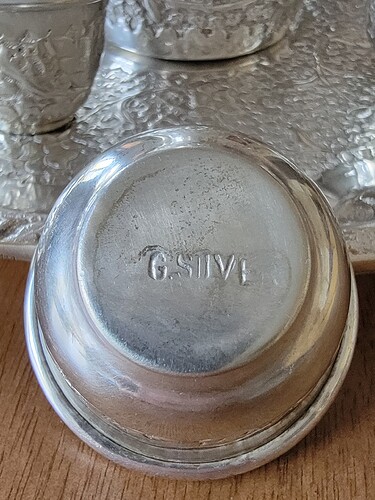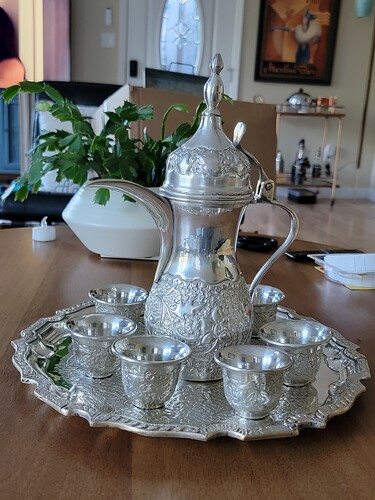I’m very new to collecting silver, so please bear with me. ![]() I picked up this Dallah tea set. The only marking is “G Silver”. Can anyone shed any light on the manufacturer?
I picked up this Dallah tea set. The only marking is “G Silver”. Can anyone shed any light on the manufacturer?
It’s certainly Turkish, though I would say “coffee” rather than “tea,” based on the high-mounted spout.
Beyond that, I can’t help. No luck finding a maker, alas. I’d hazard a guess that it’s silverplate - it would be a massive amount of sterling.
German or “G” silver is a copper alloy, commonly made with about 60% copper, 20% nickel, and 20% zinc, that does not contain actual silver but is named for its silver-like appearance.
It’s also known as nickel silver and was created to be a more affordable alternative to real silver for items like jewelry, cutlery, and other decorative objects.
I don’t know enough about design to tell you where it came from or who made it, but I have been served Qahwa from vessels like it in both Asia and Africa.
Qahwa is a highly spiced Arabian coffee used to show hospitality in a culture where alcohol is prohibited.
I wouldn’t have thought the solid metal cups were all that practical as the pot, or cevze in Turkey, and its contents typically sit in the embers of a fire or on a stove and the heat would make holding it contents in a metal cup uncomfortable.
So this may have been a largely decorative item which would explain its pristine appearance.
I note the deposits of apparent tarnish in the cracks and joins. Nickel or German silver generally does not tarnish as fast as sterling silver or plate so again evidence it has been sitting on a shelf for a long time rather than being used
The fact it is not silver or even silver plate should not distress you It’s the work on it that lends it value.
If it is Turkish in origin and had it been sold there as silver that government does require clear marking and it would be a punishable offence to have misrepresented it. However the defence would be it is clearly marked German or G Silver and therefore no offence took place.
CRWW
Yes, I agree that this is “German silver.” Should have thought of it myself - just too obvious, I guess. We’re sometimes blindsided when something is spelled out for us. ![]()
As far as origins go, a search for “Turkish tea service/set” should remove all doubt. Lots of variations (enameling, for example, some of it quite gaudy), but an unmistakable design.
I think we can say it looks like a Turkish production. I m not sure we should say anything more. While earning my crust in this part of the world I met a lot of tinkers – people selling metal to the locals which looked like it was made locally but was actually cast or banged out somewhere else completely. One guy I met from Carlisle, UK in Alexandra was drumming for a European company making this sort of gear.
Mike offered me a ride out of Egypt which I accepted. He was heading to Damascus. I needed to get to Beirut where my boss and paycheque was. We set out in his battered Austin Seven via Aqaba through Jordan and up into Syria. Where we were stopped by a group of locals who seemed more interested in the car than buying Mike’s pots and pans. They offered two “virgins” and some goats. It might have been a great offer but we were a long way from our final destination and the offer to two females who spoke not a word of English wasn’t all that attractive. We refused which turned out to be a big mistake.
As is so often the case, it was Bart’s research on near silver and the remarks in his referenced article that found the G silver spot.
As to not thinking about it Jeff,I am reminded of the exchange between James Whistler the artist and Oscar Wilde the playwright in a similar situation.
CRWW
Thank You, Christopher! I feel honored and appreciated.

